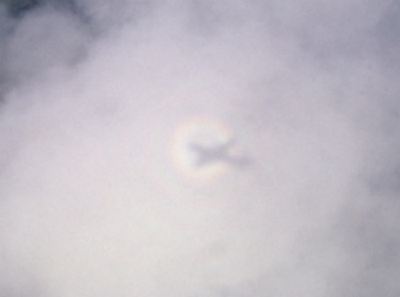 |
 |
| Home | Welcome | What's New | Site Map | Glossary | Weather Doctor Amazon Store | Book Store | Accolades | Email Us |
 | |||||||||
The Glory and the Brockenspectre
When German mountaineers in the early nineteenth century saw the phenomenon, they attributed it to a haloed spirit beckoning them and named it the Brockenspectre. Its name derives from the Brocken, a prominent peak in Germany's Harz Mountains, where these mountaineers first saw it. The legend surrounding the Brockenspectre tells us one mountaineer became startled when confronted by the haloed human form hovering in the clouds before him. Here, some accounts suggest the vision so unnerved him that he lost his grip and fell to his death. Other versions report he was drawn to approach the visage and thus fell to his end. Prior to the advent of regular high-altitude flight, the glory appeared only to those who ascended to high mountain elevations. Today, we can see glories regularly from aircraft flying in the sunlight above uniform cloud decks. With a high sun above the aircraft, the glory is visible around the aircraft's shadow, projected onto cloud tops thousands of feet below. The glory surrounding the shadow races with the aircraft across the sky. A glory is only visible when sunlight is at the observer's back; therefore, they are always exactly opposite the sun, centered on the antisolar point. A glory will appear if that light entering into a cloud or fog bank is scattered or reflected backward to an observer's eye. Diffraction of the light bends the returning light rays slightly as they pass around the edges of uniformly-sized cloud water droplets. Interference among overlapping, returning waves produces light and dark bands that form the glory. Dark bands in the glory rings result from destructive interference when overlapping rays have their waveforms 180 degrees out of phase, and as a result, the low portion of one wave cancels the high portion of another.  Aircraft Glory: Credit: NOAA/AOML/Hurricane Research DivisionGlories appear as a full circle, their coloured rings centered on the observer's shadow. The angular spread depends only on droplet size, not on the distance to the cloud or fog bank. Typically, glories measure five to twenty degrees across. Smaller droplets produce larger glories. And the more uniform the droplet-size distribution, the more distinct the rings appear. The large size of the observer's shadow is due to its extent through a depth of several metres, rather than lying in one plane. The glory center generally shines the brightest with darker rings surrounding it. When glory rings are coloured, red always lies on the outside edge of the ring. The degree of diffraction depends on the light's wavelength relative to the cloud droplet size. Frequently, a second concentric circle appears, with a ratio of about 1 to 3 between the diameters of the first and second dark rings. Most glories appear to viewers at very high elevations or altitude. But with proper lighting conditions, they can occur anywhere uniform-sized water droplets are suspended in the air ahead of the observer if the light source is at a lower elevation. At high latitudes, glory can appear from lower topographical features, perhaps even from high-rise buildings, when the sun sits low in the sky behind the observer and a cloud, fog, or mist lies ahead. [For a collection of glory and brockenspectre photos, see this site: Brockengespenst und Glorie - Spectre of the Brocken and Glories Learn More From These Relevant Books
|
|||||||||
 |
To Purchase Notecard, |
Now Available! Order Today! | |
 |
 |
NEW! Now Available in the US! |
The BC Weather Book: |


